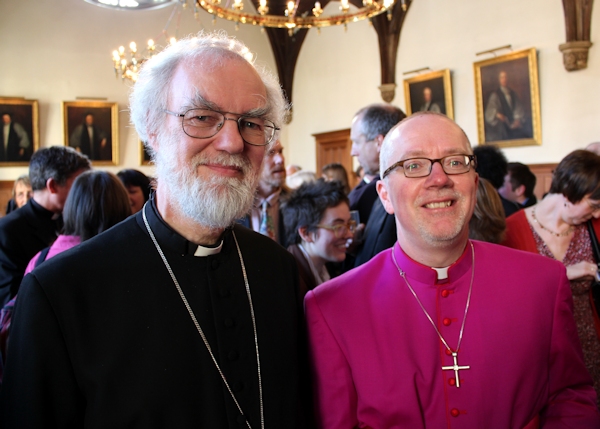Father Simon lectures at Moorlands Bible College
At the request of Alistair McKitterick, Tutor and Lecturer in Biblical and Theological Studies, Father Simon Smyth returned once again to Moorlands Bible College, on Wednesday 21st March, to give an illustrated lecture on iconography. This was the fourth time he had lectured on this subject. He was gratified to meet in reception a student who had now graduated with a First Class Honours degree present at last year’s lecture and had clearly enjoyed it, explaining that his highest mark was for the Spirituality module which included iconography.
The lecture considered many aspects of iconography including the apparent prohibition on images in the Ten Commandments. Father Simon explained that these verses in Exodus must be understood in the light and context of other Old Testament verses which showed that there were images of cherubim on the very Ark of the Covenant itself, on the veil or curtain of the Holy of Holies, on the doors, the walls, the furnishings and there were two huge cherubim in the sanctuary, then added that Orthodox Christians also love to see images or icons of angels when we worship and there was an audible intake of breath and a soft “Wow!” from one of the students at the next illustration, from the ceiling of an Ethiopian Church:
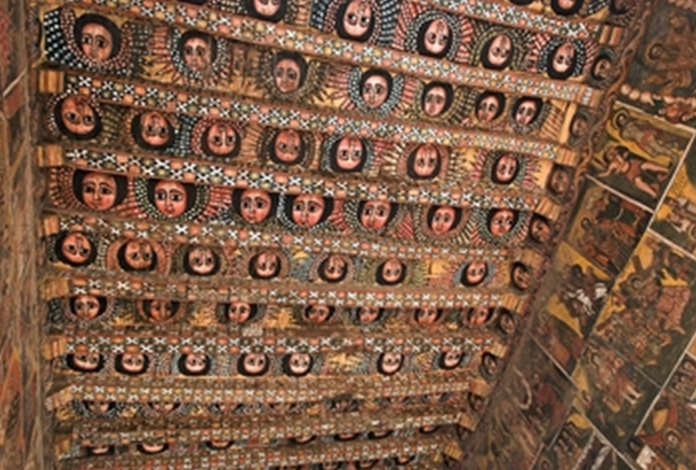
The lecture continued that Orthodox go further than the Old Testament worshippers, “we dare to depict not only the angels who worship God but even God Whom they worship…” and so began a consideration of Christology, that as God had become physical and material so physical or material icons declared and proclaimed the truth of the Incarnation.
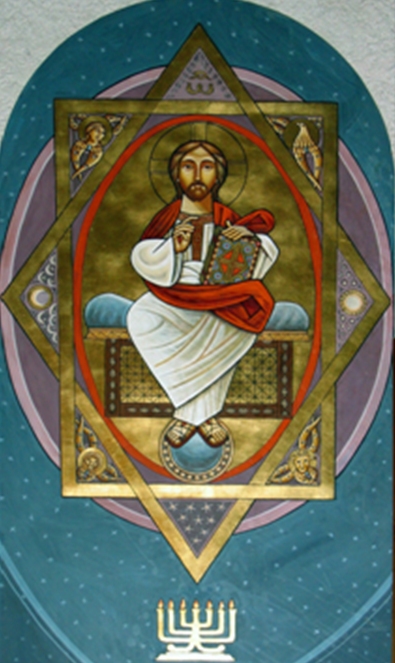
There was a detailed analysis of a modern Coptic icon of our Lord God and Saviour Jesus Christ, explaining the significance of the halo (sign of divinity), the cross within the halo (it is the Crucified One Who is God), the Alpha and Omega, the seven-branched candlestick, the sun, moon and stars, the four incorporeal creatures, His throne heaven, the earth His footstool – and the one finger raised in blessing, one finger with three joints symbolic of the Holy Trinity, One God yet Three Persons and also symbolic of the true Christology of our Oriental Orthodox Christian Faith in the One Nature of God the Word Incarnate.
Several students commented how helpful they had found the lecture, especially the emphasis on Christology being at the heart of our Orthodox Faith, how what we believe about Christ informs what we then believe about everything else.
Holy Synod meets in Cairo

Abba Seraphim writes from Cairo: “The meeting of the Holy Synod which was held on 22 March was memorable for a number of reasons. In fact it was a joint meeting of the Holy Synod, the Maglis Milli (Coptic Community Council) and the Al Awkaf (Council for Church Endowments), so there were also a number of laity present. The session was opened by H.E. Metropolitan Bishoy, General Secretary of the Holy Synod, who spoke respectfully of the church’s loss of H.H. Pope Shenouda and, havimg circulated the 1957 Statutes governing the procedure to be followed after the death of a Pope, reminded us that our first task was to formally elect a locum tenens (sometimes called an Acting Patriarch) for the Church. By seniority this would fall to Metropolitan Mikhael of Assuit, but as he is a nonogenerian, he had humbly waived all rights and proposed that Metropolitan Bakhomious should preside. Whilst seniority is respected, the Synod is free to chose whoever it wishes from among its number. However, the unanimous choice of Metropolitan Bakhomious which followed owed nothing to his seniority and everything to the respect and affection in which he is held by those present. This election was made by 86 bishops and 20 members of the laity. As locum tenens, he will enjoy all the powers of the Pope with the exception of ordaining new bishops during the interregnum.
Assuming his position, the Metropolitan thanked the Synod for its confidence in him and expressed his unworthiness. He spoke of the critical times through which the church is passing and read from Ephesians IV: 1-6. He emphasised the necessity of living according to these verses and desired that we might live in love, peace and unity as we desire to know the will of God and to discover where the Lord is leading His church. Accordingly he encouraged everyone present to speak and be heard in that same spirit. There can be no room for individual interests, Pope Shenouda has left us with a precious treasure. The Church places us in a unique position; we cannot disappoint the people and we carry the responsibility together. It is our task to steer the ship of the church safely into the harbour.
The Synod lasted for five hours, 25 minutes, the longest session in recent memory, and many bishops and laity spoke constructively of their vision for the church’s future and addressed the many issues needing to be considered. It was a long, but fruitful meeting and there was a refeshing openness of debate. The next meeting of the Synod will be held on 27 March and Metropolitan Bakhomious indicated that, if necessary, it would meet twice a week to deal with all the required business. The public will be kept informed of its decisions and progress in the preparations for electing a new Pope by official statements issued from the Patriarchate.”
Abba Seraphim returns to London late on 23 March and will be attending the Memorial Service for H.H. Pope Shenouda III to be held at St. George’s Cathedral, Stevenage, on Saturday, 24 March at 3.00 p.m. He will be celebrating the Divine Liturgy as scheduled at Charlton on Sunday, 25 March.
News from Cairo
On 21 March Abba Seraphim visited His Grace Athanasios of the French Coptic Orthodox at St. Mark’s Centre, Nasr City, to greet him and discuss matters of common interest for the church in France and the British Orthodox Church. Abba Athanasius extended a warm welcome to Abba Seraphim to visit France later this year and Abba Seraphim reciprocated with an invitation to the United Kingdom.
At the Patriarchate in Anba Rueiss Their Eminences Metropolitan Bakhomious of Beheira and Metropolitan Bishoy of Damiette (General Secretary of the Holy Synod), supported by a number of bishops, spent the whole day receiving a stream of visitors who had come to offer condolences on the death of H.H. Pope Shenouda.
On 22 March the Holy Synod, the Maglis Milli (Coptic Community Council) and Council for Church Endowments (Al Awkaf) will meet together at the Patriarchate to begin the process leading to the election of a new Pope.
The Pope’s Funeral & burial at St. Bishoy’s monastery

On 20 March Abba Seraphim, along with other members of the Holy Synod of the Coptic Orthodox Church, representatives of Christian Churches, Islamic religious leaders, diplomats, high Egyptian state and military officials, politicians and thousands of ordinary people, attended the Funeral of His Holiness Pope Shenouda III in St. Mark’s Cathedral, Abbeseya. An official day of mourning had been declared throughout Egypt. with flags flying at half-mast whilst the streets around the cathedral were lined with hundreds of soldiers. Loudspeakers broadcast the service into the surrounding streets. His Holiness’s body, which had been transferred the previous evening from the Throne of St. Mark to an impressive white casket, lay in front of the sanctuary in the midst of the khorus with the lid opened to reveal his face. This image of him, looking peaceful in death, had already become familiar as it had appeared on the front page of most national newspapers as well as having been widely viewed on television during his public lying-in-state, when thousands of mourners had passed through the cathedral to take their leave of a beloved father.
The funeral was preceded by another celebration of the Divine Liturgy, by members of the Holy Synod, presided over by His Eminence Metropolitan Bakhomious of Beheira. New carpets had been laid at the entrance to the khorus and the steps to the sanctuary were lined with an abundance of fragrant white flowers. Although the cathedral was packed, guests continued to arrive throughout the service. While the crowd waited a huge wave of clapping spontaneously burst out among the congregation as a bird, which had flown into the cathedral, soured above them. For many this symbolised the passing of the Pope’s spirit to the heavenly realm.
The funeral service commenced with prayers and a chant in Ge’ez by His Holiness Abune Paulos, the Patriarch of Ethiopia, who also spoke movingly of Pope Shenouda’s great legacy to the church. After this His Holiness Mar Ignatius Zakka I Iwas, Patriarch of Antioch, frail and confined to a wheelchair, also spoke in a powerful voice about the Pope and led the chanting of funeral hymns by accompanying Syriac bishops. Many of the officiating clergy and those in the congregation were visibly moved. When the dignified figure of Metropolitan Bakhomious addressed the congregation in a hearfelt tribute to the Pope’s work and enduring legacy, the crowd heard him in rapt attention, but his spontaneous sentiments so eloquently expressed so perfectly captured the feelings of many and roused them to deafening applause. The service concluded as the casket was carried into the sanctuary by priests and then, assisted by soldiers down the north steps from the cathedral to a waiting white ambulance. This was conducted by outriders and police cars to a military airfield in the suburbs of Cairo. As it left the Patriarchate many of the awaiting crowd surged forward to be near it and the frenzied worshippers chased out of the precincts, beating following cars in an expression of their sadness and grief. It had been intended to fly members of the Holy Synod in an additional military plane accompanying the one used for taking His Holiness to an airfield in the Wadi Natrun, but at the last minute these plans were changed, so only about a third of the members attended the burial at St. Bishoy’s monastery.

Abba Seraphim accompanied His Grace Bishop Angaelos by car to the monastery, where they joined just over a hundred monks in the small building in the ancient precincts, which had been constructed in 2003 to serve as a monastic museum, but which had now been transformed into a tomb. Built in the shape of a cross, with four semi-domes in each apse containing traditional Coptic ikons, a white marble sarcophagus had been erected in the centre. The waiting monks had already dropped fragrant herbs and spices into the tomb and those crowded outside the tomb were passing small folded slips of papers containing prayer requests, which the monks also dropped into the sarcophagus. While everyone waited the monks lustily sang Coptic hymns, proud that their Pope, always first a simple monk, was finally coming back to be with them. Soon after dusk had fallen the casket, accompanied by Metropolitan Bakhomious and other bishops, who had travelled on the plane, was brought into the monastery. Overwhelmed by grief the crowd outside exploded into shouts and wailing and many others pushed forward behind the cortege so that the previously still tomb, where those inside had probably risen to two hundred, burst into frantic activity as the soldiers and monks attempted to lower the casket into the sarcophagus and place the great marble slab on the top. Flowers and fragrant oil was poured on the top and the sarcophagus received the first of many anointings, while mourners lovingly kissed the resting place of a most beloved Pope. This will surely be a foremost place of pilgrimage for Copts and all who respect the memory and legacy of Pope Shenouda and will also be a source of many blessings for generations to come.

Photograph Sources: Facebook and OCP
Consecration of the Bishops of Croydon and Woolwich
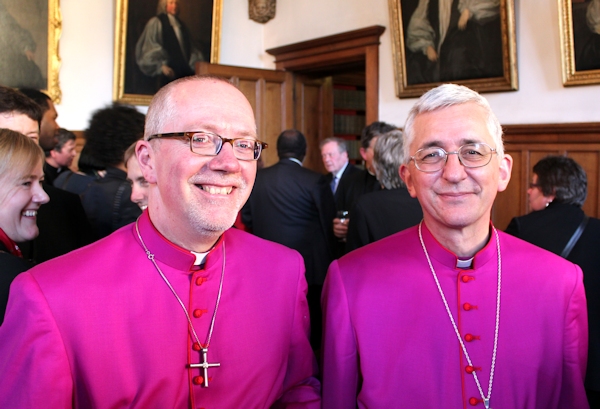
As a result of Abba Seraphim’s absence in Egypt following the sudden death of H.H. Pope Shenouda, he was obliged to cancel a number of important engagements. One of these was the consecration of two new suffragen bishops for the Anglican Diocese of Southwark, which took place at Southwark Cathedral on 21 March. He was represented, however, by his Secretary, who conveyed greetings on Abba Seraphim’s behalf to the new bishops as well as the Archbishop of Canterbury and Bishop of Southwark.
The new bishops, The Right Rev’d Dr Michael Ipgrave, Bishop of Woolwich, and The Right Rev’d Jonathan Clark, Bishop of Croydon, were consecrated in Southwark Cathedral, in the presence of a large congregation. The Archbishop of Canterbury, who was principal consecrator, movingly spoke of the death of H.H. Pope Shenouda, and offered condolences to His Grace Bishop Angaelos, who also had been unable to attend.
In his sermon, The Very Reverend Andrew Nunn, Dean of Southwark gave an entertaining view on the sights of Croydon, followed by speaking about the importance of reaching out to the community and enticing the secular society back into churches and linked this with the newly unveiled “Die Harder” statue of our Lord on the cross, constructed out of wire coat hangers.
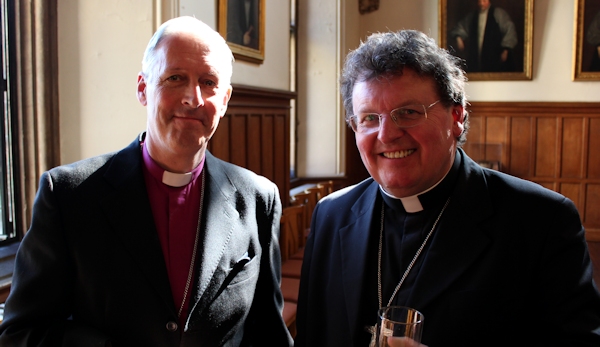
At the reception, which followed at Lambeth Palace, Mr. Maskery observed to the new bishops that as the British Orthodox Church’s secretariat is based in Charlton in south-east London, we felt it was important to welcome both Bishops to their new sees and hopefully begin a close working relationship with them, just as we have shared the same with the Bishop of Southwark during his previous ministry as Bishop of Woolwich and continue to do so.
 The Archbishop of Canterbury discussed with Mr Maskery the departure of the Pope and the future of the Coptic people. He held them in his prayers. The Bishop of Southwark expressed the same views and expressed his sorrow at the death of Pope Shenouda and said that he would be representing the Archbishop of Canterbury at this Saturday’s Coptic Memorial Service to be held at St. George’s Cathedral in Stevenage.
The Archbishop of Canterbury discussed with Mr Maskery the departure of the Pope and the future of the Coptic people. He held them in his prayers. The Bishop of Southwark expressed the same views and expressed his sorrow at the death of Pope Shenouda and said that he would be representing the Archbishop of Canterbury at this Saturday’s Coptic Memorial Service to be held at St. George’s Cathedral in Stevenage.
